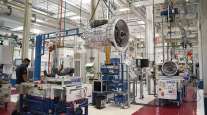Navistar's 4Q Profit Jumps; OEM Reports Shortage of Castings
This story appears in the Jan. 2 print edition of Transport Topics.
Profit surged at truck and engine maker Navistar International Corp. during the fiscal fourth quarter as its three main divisions — trucks, engines and parts — all posted stronger results.
The Lisle, Ill., original equipment manufacturer earned $275 million, or $3.48 a share, on revenue of $4.32 billion for the three months ended Oct. 31. Year-earlier earnings were $50 million, or 61 cents a share, on revenue of $3.37 billion.
“We are pleased that we have finished the year strong and delivered solid fourth-quarter results across all segments,” said Chairman and CEO Daniel Ustian.
During a Dec. 20 earnings call, Ustian said that, while he expects North American truck sales volumes to increase in the current fiscal year over the one just ended, Navistar sales will be relatively slow through January, in part because of an industrywide shortage of castings for engine parts.
He also said the company will file for a secondary certification of its third-generation exhaust gas recirculation engine technology “in the very short term” with the Environmental Protection Agency.
Navistar said its annual revenue rose to $13.96 billion from $12.14 billion. Analysis of annual profits was complicated by a one-time, third-quarter balance sheet adjustment of $1.46 billion. However, income before taxes, which did not include the special credit, expanded to $320 million for the full fiscal year, from $290 million.
OEMs spoke frequently of part and component shortages for much of 2011, with tires, axles and diesel-particulate-filter substrates receiving particular attention. Ustian said early in his remarks to stock analysts that “most of them were cleared up,” but he then offered a new issue.
“The foundry industry has lost its capacity for this type of casting now for several years,” Ustian said, adding that the company’s Indianapolis foundry — once headed for closing — was retooled to work with compacted-graphite iron and is now a source of in-house capacity.
Ustian said the production adjustments will run at least through the end of the fiscal first quarter on Jan. 31 — typically Navistar’s slowest period for truck sales. He said volumes should accelerate around the second quarter.
Regarding engine certification, Navistar’s heavy-duty MaxxForce engines have met 2010 EPA standards for diesel engines through a combination of lower emissions and emission credits. Ustian said the company would talk more about this at its Feb. 1 analysts’ meeting, but in general, improvements in air handling, fuel combustion and electronic controls will soon enable the company to meet the federal standard of 0.2 gram emissions of nitrogen oxide per brake horsepower-hour without the use of credits.
Ustian said the first engine the company sends to EPA will be its 13-liter MaxxForce, the mainstay of its Class 8 fleet.
During the most recent quarter, the company’s truck division operating income was $287 million on revenue of $3.18 billion. In the same quarter a year earlier, it earned $86 million on revenue of $2.33 billion.
For the year, truck division profit was $336 million after $173 million in one-time spending for North American manufacturing restructuring and integration of engineering facilities.
The engine division made $58 million on quarterly sales of $575 million. A year ago it lost $17 million on revenue of $506 million.
Quarterly parts division profits rose to $87 million for $77 million, as revenue jumped to $522 million from $479 million.
U.S.-Canadian business brought in the most revenue — $10.67 billion for the year — but grew by only 8%. Annual revenues from the rest of the world expanded by 48% to $3.28 billion.
Ustian said South America and India were Navistar’s best foreign markets.




